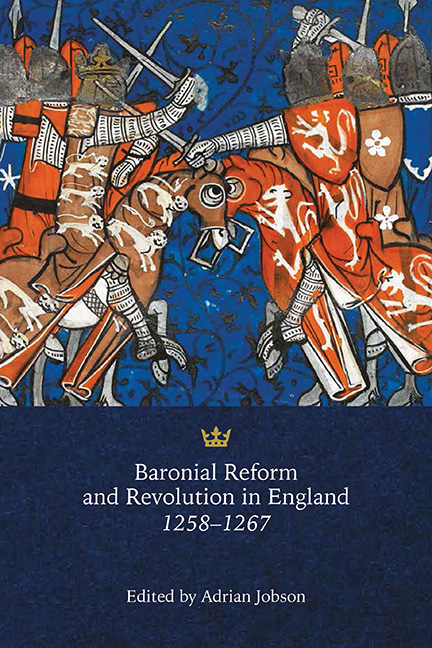Book contents
- Frontmatter
- Dedication
- Contents
- List of Illustrations
- Acknowledgements
- List of Abbreviations
- Introduction
- Modern Historians and the Period of Reform and Rebellion, 1258–1265
- The Secret Revolution of 1258
- Baronial Reform, the Justiciar’s Court and Commercial Legislation: The Case of Grimsby
- Crisis Management: Baronial Reform at the Exchequer
- Local Administration during the Period of Reform and Rebellion
- What Happened in 1261?
- Writing Reform and Rebellion
- Civic Government in Troubled Times: London c.1263–1270
- The Montfortian Bishops
- Reformers and Royalists: Aristocratic Women in Politics, 1258–1267
- The Midlands Knights and the Barons’ War: The Warwickshire Evidence
- Retinues, Agents and Garrisons during the Barons’ Wars
- The Barons’ War in the North of England, 1264–1265
- The Maritime Theatre, 1258–1267
- Reasserting Medieval Kingship: King Henry III and the Dictum of Kenilworth
- Index
The Midlands Knights and the Barons’ War: The Warwickshire Evidence
Published online by Cambridge University Press: 21 May 2021
- Frontmatter
- Dedication
- Contents
- List of Illustrations
- Acknowledgements
- List of Abbreviations
- Introduction
- Modern Historians and the Period of Reform and Rebellion, 1258–1265
- The Secret Revolution of 1258
- Baronial Reform, the Justiciar’s Court and Commercial Legislation: The Case of Grimsby
- Crisis Management: Baronial Reform at the Exchequer
- Local Administration during the Period of Reform and Rebellion
- What Happened in 1261?
- Writing Reform and Rebellion
- Civic Government in Troubled Times: London c.1263–1270
- The Montfortian Bishops
- Reformers and Royalists: Aristocratic Women in Politics, 1258–1267
- The Midlands Knights and the Barons’ War: The Warwickshire Evidence
- Retinues, Agents and Garrisons during the Barons’ Wars
- The Barons’ War in the North of England, 1264–1265
- The Maritime Theatre, 1258–1267
- Reasserting Medieval Kingship: King Henry III and the Dictum of Kenilworth
- Index
Summary
The deep and profound impact of the Barons’ War on the county of Warwickshire and its local gentry caused a drastic reshaping of the political landscape. Warwick Castle's fall in April 1264 represented the first military engagement in the county; the capture and subsequent razing of its walls by the baronial supporter John Giffard was an immediate response to the rebel defeat at Northampton a few days earlier. Similarly, in the rebellion's final months, it was Simon de Montfort's caput at Kenilworth that became the conflict's main focus. On 2 August 1265, the Lord Edward successfully attacked a rebel army as it slept outside the fortress's walls. But even after Montfort's death at Evesham just two days later, Kenilworth's rebel garrison still exerted its influence over the Warwickshire countryside. Contemporaries noted that their defiant actions caused widespread plunder and destruction. Indeed, the disruption impacted on local administration: William Bagot, Warwickshire's sheriff, claimed that no county courts had been held between 1265 and 1267 because of deliberate obstruction by Kenilworth's garrison and their disgruntled comrades on the Isle of Ely in Cambridgeshire. It was not until the garrison's surrender in December 1266 that the focal point for the county's disruption was finally eradicated.
More dramatic than the deterioration of local administration was the loss of life within the ranks of Warwickshire's gentry of those who actively participated in the Barons’ War. Many knights and lesser barons were killed fighting for Simon de Montfort, earl of Leicester, at Evesham: amongst the casualties were prominent local figures, including Peter de Montfort, William of Birmingham, Thomas of Astley and Richard de Trussel. These deaths compelled various county knights, who had been connected with these lesser rebel barons during the recent conflict, to forge links with the new forces in local society. Two Warwickshire grand assize jurors, Robert Hastang and Robert de Verdon, both followed Peter de Montfort in the early 1260s. A decade later, however, they were attesting charters of the local royalist Langley family.
Even a cursory outline of the events in Warwickshire during the period of baronial reform and rebellion makes it clear that the county's knights, like their colleagues and associates elsewhere in the kingdom, played a vital role.
- Type
- Chapter
- Information
- Baronial Reform and Revolution in England, 1258-1267 , pp. 167 - 182Publisher: Boydell & BrewerPrint publication year: 2016



